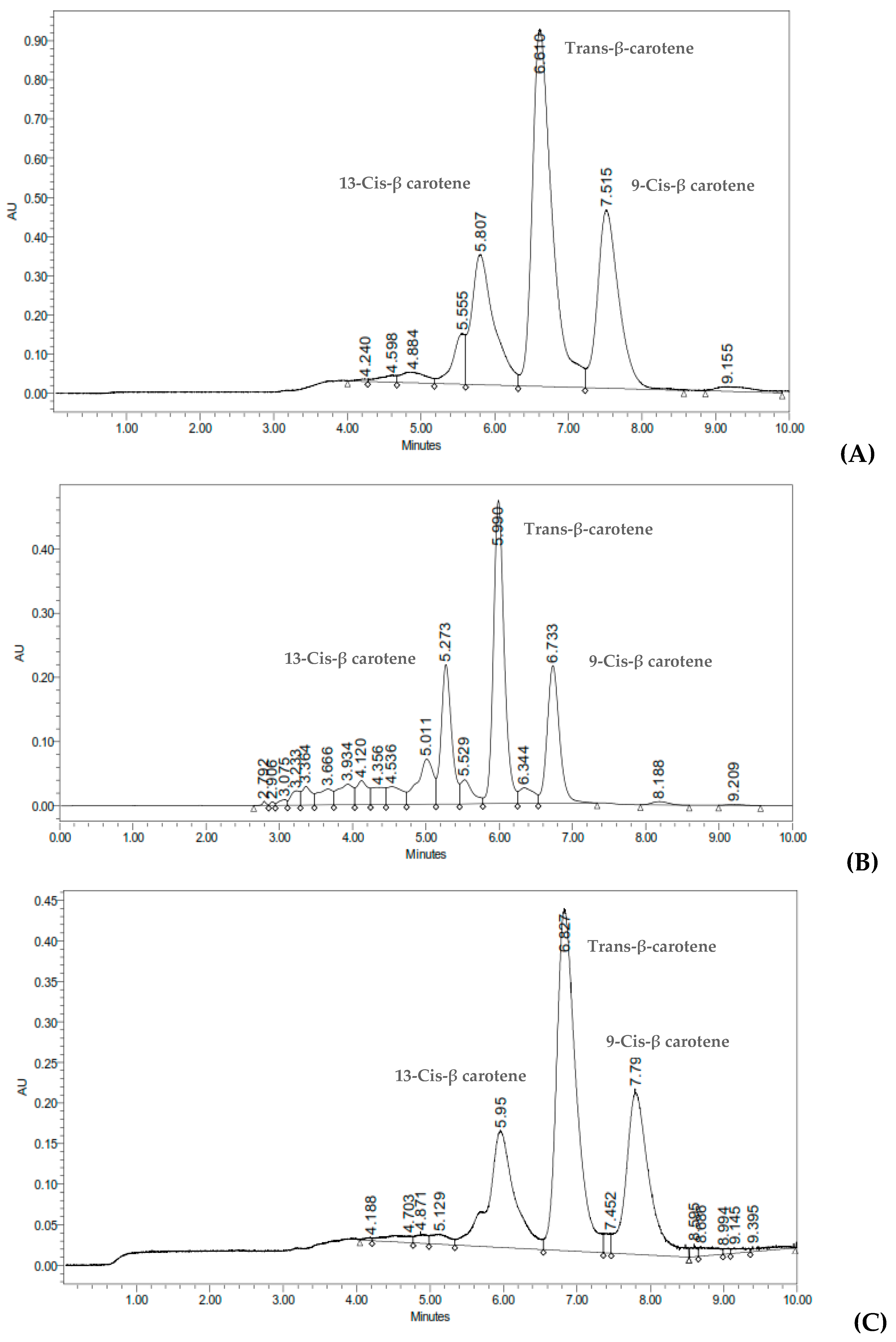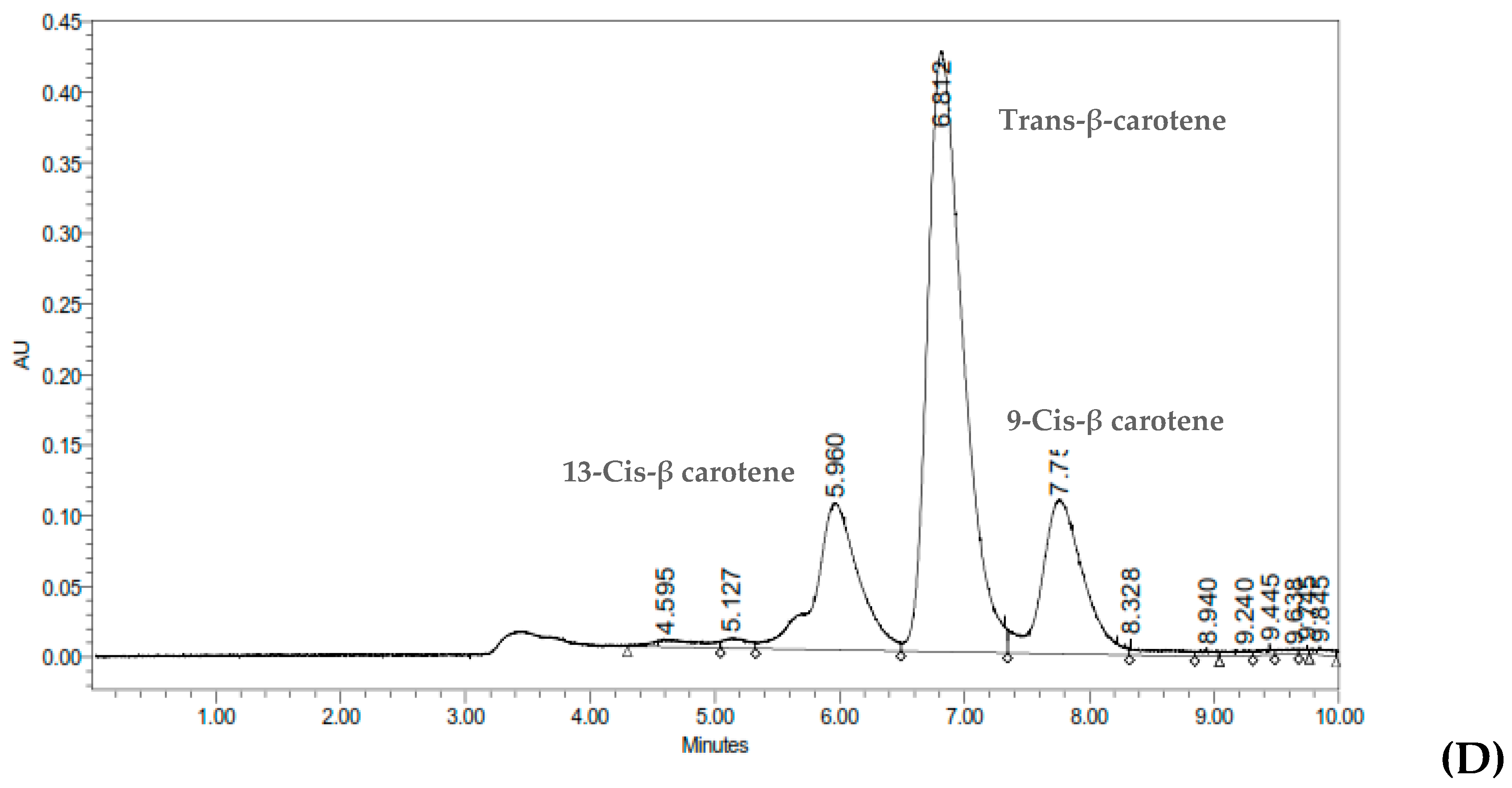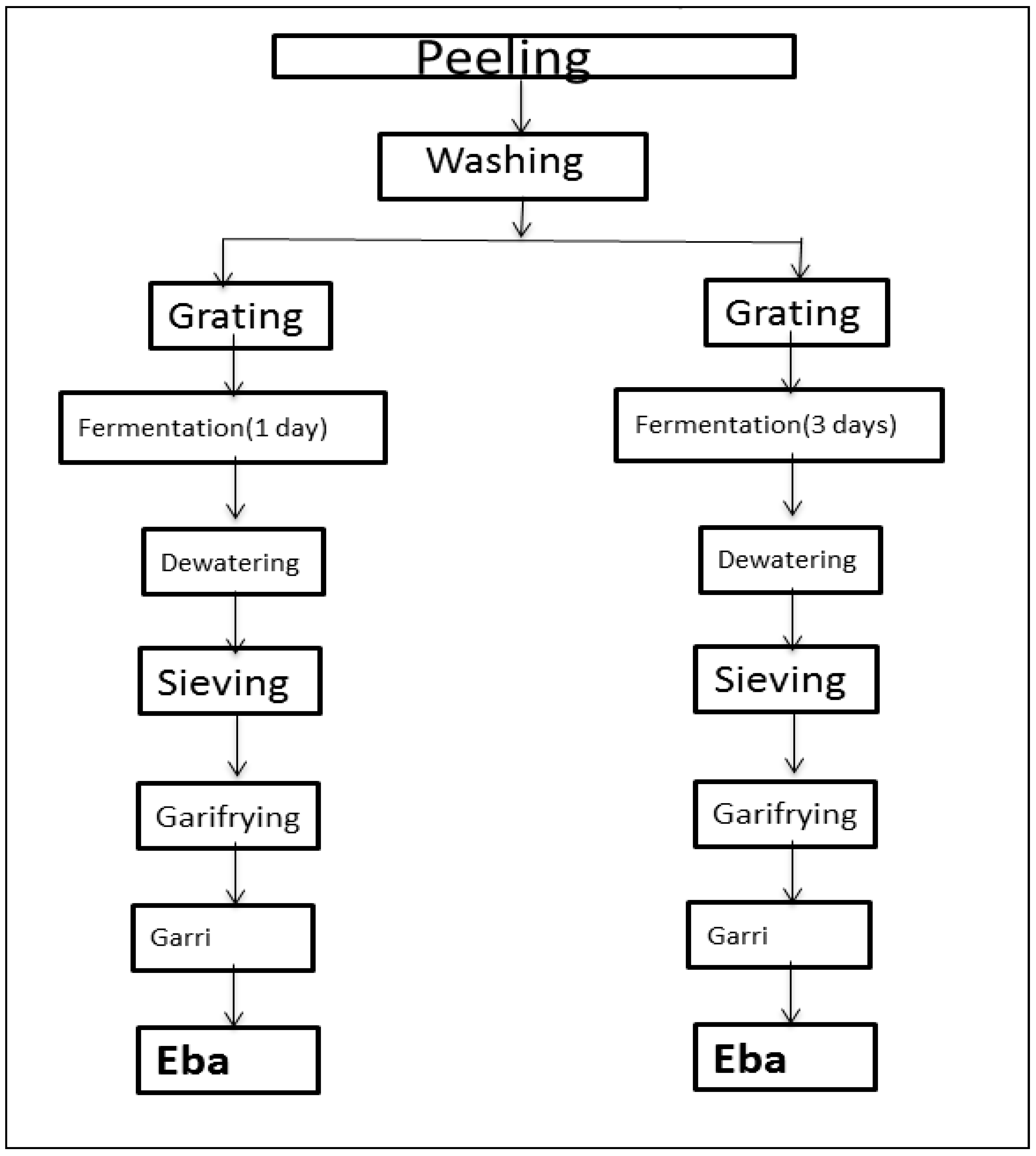Retention of Pro-Vitamin A Content in Products from New Biofortified Cassava Varieties
Abstract
1. Introduction
2. Materials and Methods
2.1. Experimental Design
2.2. Harvesting and Processing
2.3. β-Carotene Extraction and HPLC Analysis
2.4. Dry Matter Content
2.5. True Retention Calculation
2.6. Dietary Intake Assessment
2.7. Estimation of Possible Contribution to Vitamin A Intake
2.8. Statistical Analysis
3. Results and Discussion
3.1. β-Carotene Concentrations and Retention
3.2. Statistical Interaction between Varieties and Processing Methods
3.3. Dietary Intake and Possible Nutrient Intake
4. Conclusions
Author Contributions
Funding
Acknowledgments
Conflicts of Interest
Appendix A
| β-Carotene of raw = 212 µg/g | β-Carotene of G6 mash = 198 µg/g |
| Weight of raw = 600 g | Weight of G6 mash = 560 g |
| Dry matter of raw = 28% | Dry matter of G6 mash = 23% |
Appendix B
Appendix C


References
- WHO (World Health Organization). Micronutrient Deficiencies. Available online: www.who.int/nutrition/topics/vad/en/ (accessed on 15 January 2018).
- Nestel, P.; Bouis, H.E.; Meenakshi, J.V.; Pfeiffer, W. Biofortification of staple food crops. J. Nutr. 2006, 136, 1064–1067. [Google Scholar] [CrossRef]
- Neidecker-Gonzales, O.; Nestel, P.; Bouis, H. Estimating the global costs of vitamin A capsule supplementation: A review of the literature. Food Nutr. Bull. 2007, 28, 307–316. [Google Scholar] [CrossRef] [PubMed]
- Meenakshi, J.V. Cost Effectiveness of Biofortification Copenhagen Consensus Center 2008. Results. pp. 1–6. The Copenhagen Centre, Frederiksberg, Denmark. Available online: http://www.copenhagenconsensus.com (accessed on 17 August 2017).
- Hahn, S.K. An overview of African traditional cassava processing and utilization. Outlook Agric. 1990, 18, 110–118. [Google Scholar] [CrossRef]
- Allen, C.A. The origin of Manihot esculenta Crantz (Euphorbiaceae). Gen. Res. Crop Evol. 1994, 41, 133–150. [Google Scholar] [CrossRef]
- Balagopalan, C. Cassava utilization in food, feed and industry (Chapter 15). In Cassava: Biology, Production and Utilization; Hillocks, R.J., Thresh, J.M., Bellotti, A.C., Eds.; CABI Publisher: Wallingford, UK, 2002; pp. 301–318. [Google Scholar]
- Montagnac, J.A.; Davis, C.R.; Tanumihardjo, S.A. Nutritional value of cassava for use as a staple food and recent advances for improvement. Comp. Rev. Food Sci. Food Saf. 2009, 8, 181–194. [Google Scholar] [CrossRef]
- Felber, C.; Azouma, Y.O.; Reppich, M. Evaluation of analytical methods for the determination of the physicochemical properties of fermented, granulated, and roasted cassava pulp-gari. Food Sci. Nutr. 2017, 5, 46–53. [Google Scholar] [CrossRef] [PubMed]
- Bouis, H.E.; Christine Hotz, C.; Bonnie McClafferty, B.; Meenakshi, J.V.; Pfeiffer, W.H. Biofortification: A new tool to reduce micronutrient malnutrition. Food Nutr. Bull. 2011, 32, 31S–40S. [Google Scholar] [CrossRef] [PubMed]
- Krinsky, N.I.; Johnson, E.J. Carotenoid actions and their relation to health and disease. Mol. Asp. Med. 2005, 26, 459–516. [Google Scholar] [CrossRef]
- Sies, H.; Stahl, W. Bioactivity and protective effects of natural carotenoids. Biochim. Biophys. Acta (BBA)-Mol. Basis Dis. 2005, 1740, 101–107. [Google Scholar]
- Omodamiro, R.M.; Oti, E.; Etudaiye, H.A.; Egesi, C.; Olasanmi, B.; Ukpabi, U.J. Production of Fufu from yellow cassava roots using the odourless flour technique and the traditional method: Evaluation of carotenoids retention in the fufu. Adv. Appl. Sci. Res. 2012, 3, 2566–2572. [Google Scholar]
- International Institute of Tropical Agriculture (IITA). Available online: http://www.iita.org/news-item/nigeria-releases-cassava-higher-pro-vitamin-fight-micronutrient-deficiency/ (accessed on 27 January 2017).
- HarvestPlus. Available online: www.harvestplus.org/where-we-work/nigeria (accessed on 27 January 2017).
- Rodriguez-Amaya, D.B. Carotenoid and Food Preparation: The Retention of Provitamin a Carotenoid in Prepared, Processed, and Stored Foods; Universidade Estadual de Campinas: Campinas, Brazil, 1997. [Google Scholar]
- Maziya-Dixon, B.; Awoyale, W.; Dixon, A.G.O. Effect of Processing on the Retention of Total Carotenoid, Iron and Zinc Contents of Yellow-fleshed Cassava Roots. J. Food Nutr. Res. 2015, 3, 483–488. [Google Scholar]
- Chavez, A.L.; Sanchez, T.; Ceballos, H.; Rodriguez-Amaya, D.B.; Nestel, P.; Tohme, J.; Ishitani, M. Retention of carotenes in cassava roots submitted to different processing methods. J. Sci. Food Agric. 2007, 87, 388–393. [Google Scholar] [CrossRef]
- De Moura, F.; Miloff, A.; Boy, E. Retention of provitamin A carotenoids in staple crops targeted for biofortification in Africa: Cassava, maize and sweet potato. Crit. Rev. Food Sci. 2013, 55, 1246–1269. [Google Scholar] [CrossRef] [PubMed]
- Eyinla, T.; Sanusi, R.; Alamu, E.; Maziya-Dixon, B. Variations of β-carotene retention in a staple produced from yellow fleshed cassava roots through different drying methods. Funct. Foods Health Dis. 2018, 8, 372–384. [Google Scholar] [CrossRef]
- Bechoff, A.; Tomlins, K.I.; Chijioke, U.; Ilona, P.; Westby, A.; Boy, E. Physical losses could partially explain modest carotenoid retention in dried food products from biofortified cassava. PLoS ONE 2018, 13, e0194402. [Google Scholar] [CrossRef]
- Oke, O.L. Cassava as food in Nigeria. World Rev. Nutr. Diet. 1968, 9, 227–250. [Google Scholar]
- Bamidele, O.P.; Ogundele, F.G.; Ojubanire, B.A.; Fasogbon, M.B.; Bello, O.W. Nutritional composition of “gari” analog produced from cassava (Manihot esculenta) and cocoyam (Colocasia esculenta) tuber. Food Sci. Nutr. 2014, 2, 706–711. [Google Scholar] [CrossRef]
- Maziya-Dixon, B.; Dixon, A.G.O.; Ssemakula, G. Changes in total carotenoid content at different stages of traditional processing of yellow-fleshed cassava genotypes. Int. J. Food Sci. Technol. 2009, 44, 2350–2357. [Google Scholar] [CrossRef]
- Etejere, E.O.; Bhat, R. Traditional preparation and uses of cassava in Nigeria. Ecol. Bot. 1985, 39, 157–164. [Google Scholar] [CrossRef]
- James, B.; Okechukwu, R.U.; Abass, A.; Fannah, S.; Maziya-Dixon, B.; Sanni, L.O.; Osei-Sarfoh, A.; Fomba, S.; Lukombo, S. Producing Gari from Cassava: An Illustrated Guide for Smallholder Cassava Processors; International Institute of Tropical Agriculture (IITA): Ibadan, Nigeria, 2012. [Google Scholar]
- Cassbiz. Available online: http://www.cassavabiz.org/postharvest/2_utilisation_01.htm (accessed on 27 January 2017).
- Rodriguez-Amaya, D.B.; Kimura, M. HarvestPlus Handbook for Carotenoid Analysis; HarvestPlus Technical Monograph 2; International Food Policy Research Institute (IFPRI) and International Center for Tropical Agriculture (CIAT): Washington, DC, USA; Cali, Colombia, 2004. [Google Scholar]
- Carvalho, L.J.; Oliveira, A.G.; Godoy, R.O.; Pacheco, S.; Nutti, M.; de Carvalho, J.V.; Pereira, E.; Fukuda, W. Retention of total carotenoid and β-carotene in yellow sweet cassava (Manihot esculenta Crantz) after domestic cooking. Food Nutr. Res. 2012, 56, 15788. [Google Scholar] [CrossRef] [PubMed]
- Alamu, O.E.; Menkir, A.; Maziya-Dixon, B.; Olaofe, O. Effects of husk and harvest time on carotenoid content and acceptability of roasted fresh cobs of orange maize hybrids. Food Sci. Nutr. 2014, 2, 811–820. [Google Scholar] [CrossRef]
- Association of Official Analytical Chemists (AOAC). Official Methods of Analysis; Association of Official Analytical Chemists (AOAC): Arlington, VA, USA, 2005. [Google Scholar]
- Murphy, E.W.; Criner, P.E.; Gray, B.C. Comparisons of methods for calculating retentions of nutrients in cooked foods. J. Agric. Food Chem. 1975, 23, 1153–1157. [Google Scholar] [CrossRef]
- Maziya-Dixon, B.; Alamu, E.O.; Dufie Wireko-Manu, F.; Asiedu, R. Retention of iron and zinc in yam flour and boiled yam processed from white yam (D. rotundata) varieties. Food Sci. Nutr. 2016, 5, 662–668. [Google Scholar] [CrossRef]
- Institute of Medicine (IOM). Dietary References Intakes for Vitamin A, Vitamin K, Arsenic, Boron, Chromium, Copper, Iodine, Iron, Manganese, Molybdenum, Nickel, Silicon, Vanadium and Zinc; Food and Nutrition Board, Institute of Medicine, National Academy Press: Washington, DC, USA, 2007; pp. 82–161. [Google Scholar]
- Thakkar, S.K.; Huo, T.; Maziya-Dixon, B.; Failla, M.L. Impact of style of processing on retention and bioaccessibility of β-carotene in Cassava (Manihot esculanta, Crantz). J. Agric. Food Chem. 2009, 54, 1344–1348. [Google Scholar] [CrossRef]
- Iglesias, C.; Mayer, J.; Chavez, L.; Calle, F. Genetic potential and stability of carotene content in cassava roots. Euphytica 1997, 94, 367–373. [Google Scholar] [CrossRef]
- Simpson, K.L. Chemical changes in natural food pigments. In Chemical Changes in Food during Processing; Finley, J.W., Ed.; AVI Pub: Westport, CT, USA, 1986; pp. 409–441. [Google Scholar]
- Bendich, A. Biological functions of dietary carotenoids. Ann. N. Y. Acad. Sci. 1993, 691, 61–67. [Google Scholar] [CrossRef]
- Kevan, P.G.; Baker, H.G. Insects as flower visitors and pollinators. Ann. Rev. Entomol. 1983, 28, 407–453. [Google Scholar] [CrossRef]
- Taleon, V.; Sumbu, D.; Muzhingi, T.; Bidiaka, S. Carotenoids retention in biofortified yellow cassava processed with traditional African methods. J. Sci. Food Agric. 2019, 99, 1434–1441. [Google Scholar] [CrossRef]
- Onadipe-Phorbee, O.; Olayiwola, I.; Sanni, S. Bioavailability of Beta Carotene in Traditional Fermented, Roasted Granules, Gari from Bio-Fortified Cassava Roots. Food Nutr. Sci. 2013, 4, 1247–1254. [Google Scholar] [CrossRef]
- Maziya-Dixon, B.; Akinyele, I.O.; Oguntona, E.B.; Nokoe, S.; Sanusi, R.A.; Harris, E. Nigeria Food Consumption and Nutrition Survey 2001–2003; International Institute of Tropical Agriculture (IITA): Ibadan, Nigeria, 2004. [Google Scholar]
- McDowell, I.; Oduro, K.A. Investigation of the beta-carotene content of yellow varieties of cassava. J. Plant Food 1981, 5, 169–171. [Google Scholar] [CrossRef]
- La Frano, M.R.; Woodhouse, L.R.; Burnett, D.J.; Burri, B.J. Biofortified cassava increases β-carotene and vitamin A concentrations in the TAG-rich plasma layer of American women. Br. J. Nutr. 2013, 110, 310–320. [Google Scholar] [CrossRef]
- Wossen, T.; Tessema, G.; Abdoulaye, T.; Rabbi, I.; Olanrewaju, A.; Alene, A.; Feleke, S.; Kulakow, P.; Asumugha, G.; Adebayo, A.; et al. The Cassava Monitoring Survey in Nigeria Final Report; IITA: Ibadan, Nigeria, 2017; 66p. [Google Scholar]
- Asegbeloyin, J.N.; Onyimonyi, A.E. The effects of different processing methods on the residual cyanide of Gari. Pak. J. Nutr. 2007, 62, 163–166. [Google Scholar]
- Makanjuola, O.M.; Ogunmodede, A.S.; Makanjuola, J.O.; Awonorin, S.O. Comparative Study on Quality Attributes of Gari Obtained from Some Processing Centres in South West, Nigeria. Adv. J. Food Sci. Technol. 2012, 4, 135–140. [Google Scholar]

| Varieties | Fresh Roots | G2 | G2 (%) | G3 | G3 (%) | G4 | G4 (%) | G5 | G5 (%) | G10 | G10 (%) |
|---|---|---|---|---|---|---|---|---|---|---|---|
| 0593 | 6.75 ± 0.07 b | 6.60 ± 0.14 c | 97.7 ± 0.42 d | 10.60 ± 0.57 a | 49.5 ± 0.71 c | 10.38 ± 0.17 c | 31.6 ± 0.57 c | 13.50 ± 0.0 a | 29.3 ± 0.0 c | 3.33 ± 0.0 c | 7.2 ± 0.0 c |
| 0539 | 6.96 ± 0.06 b | 4.03 ± 0.0 a | 76 ± 0.0 a | 11.15 ± 0.2 a | 50.3 ± 0.42 c | 6.38 ± 0.14 a | 22.3 ± 0.42 b | 17.66 ± 0.0 c | 20.8 ± 0.0 b | 1.94 ± 0.0 a | 2.1 ± 0.0 a |
| 0220 | 7.81 ± 0.13 c | 9.10 ± 0.14 d | 94 ± 1.41 c | 10.61 ± 0.0 a | 32.5 ± 0.0 a | 14.86 ± 0.0 d | 22.3 ± 0.0 b | 18.37 ± 0.18 d | 14.5 ± 0.71 a | 2.68 ± 0.03 b | 1.26 ± 0.34 a |
| 1371 | 5.32 ± 0.03 a | 5.20 ± 0.0 b | 81.7 ± 0.0 b | 11.39 ± 0.0 a | 35.4 ± 0.0 b | 7.61 ± 0.0 b | 16.8 ± 0.0 a | 15.83 ± 0.17 b | 14.4 ± 0.3 a | 3.60 ± 0.07 d | 4.3 ± 1.41 b |
| Mean | 6.71 ± 0.96 | 6.23 ± 2.02 | 87.35 ± 9.46 | 10.94 ± 0.43 | 41.93 ± 8.61 | 9.81 ± 3.48 | 23.25 ± 5.69 | 16.34 ± 2.01 | 19.73 ± 6.52 | 2.89 ± 0.69 | 3.72 ± 2.52 |
| S.E | 0.52 | 1.09 | 5.10 | 0.20 | 4.65 | 1.88 | 3.07 | 1.09 | 3.53 | 0.37 | 1.33 |
| C.V (%) | 15.4 | 35.0 | 11.7 | 3.7 | 22.2 | 38.4 | 26.4 | 13.3 | 35.8 | 25.7 | 71.4 |
| Varieties | Fresh Roots | G6 | G6 (%) | G7 | G7 (%) | G8 | G8 (%) | G9 | G9 (%) | G11 | G11 (%) |
|---|---|---|---|---|---|---|---|---|---|---|---|
| 0593 | 6.75 ± 0.07 b | 6.80 ± 0.07 bc | 92.97 ± 0.04 c | 3.89 ± 0.16 a | 21 ± 0.71 b | 3.66 ± 0.08 a | 13.04 ± 0.1 b | 7.19 ± 0.0 a | 10 ± 0.0 a | 1.52 ± 0.28 a | 5.4 ± 0.57 c |
| 0539 | 6.96 ± 0.06 b | 6.20 ± 0.28 b | 86.8 ± 0.14 b | 5.72 ± 0.00 b | 19.2 ± 0.0 a | 4.48 ± 0.0 b | 11.2 ± 0.0 a | 7.55 ± 0.57 ab | 10.39 ± 2.8 a | 1.72 ± 0.0 a | 0.05 ± 0.0 a |
| 0220 | 7.81 ± 0.13 c | 8.02 ± 0.0 c | 93 ± 0.0 c | 6.35 ± 0.00 b | 38.4 ± 0.0 c | 6.35 ± 0.0 c | 26.4 ± 0.0 c | 9.44 ± 0.31 c | 16 ± 2.83 b | 2.20 ± 0.4 a | 2.5 ± 0.71 b |
| 1371 | 5.32 ± 0.03 a | 5.1 ± 0.71 a | 72 ± 1.13 a | 4.51 ± 0.47 a | 42.7 ± 0.42 d | 6.28 ± 0.31 c | 41.85 ± 0.2 d | 8.37 ± 0.0 b | 21.7 ± 0.0 c | 3.79 ± 0.16 b | 16.57 ± 0.3 d |
| Mean | 6.71 ± 0.96 | 6.50 ± 1.02 | 86.19 ± 9.18 | 5.12 ± 1.05 | 30.33 ± 11.1 | 5.19 ± 1.25 | 23.12 ± 13.2 | 8.14 ± 0.96 | 14.52 | 2.31 ± 0.97 | 6.13 |
| S.E | 0.52 | 0.62 | 4.95 | 0.56 | 5.98 | 0.67 | 7.10 | 0.50 | 2.76 | 0.51 | 3.65 |
| C.V (%) | 15.4 | 19.2 | 11.5 | 21.9 | 39.4 | 25.8 | 61.4 | 12.3 | 37.9 | 44.5 | 119.0 |
| Products | Mash | % TR | Dewatered Mash | % TR | Sieved Mash | %TR | Fried Garri | %TR | Cooked Dough | %TR |
|---|---|---|---|---|---|---|---|---|---|---|
| P variety | 9.34 *** | 327.86 *** | 1.32 *** | 15.56 *** | 19.29 *** | 0.065 ns | 8.68 *** | 17.45 *** | 2.46 *** | 75.13 *** |
| P method | 0.08 ns | 5.36 *** | 135.59 *** | 538.24 *** | 85.19 *** | 108.29 *** | 269.95 *** | 109.31 *** | 1.35 *** | 23.33 *** |
| P variety*method | 2.423 *** | 76.25 *** | 1.51 *** | 443.11 *** | 12.59 *** | 370.64 *** | 2.74 *** | 142.36 ** | 0.75 *** | 45.40 *** |
| Product | Children | Adolescents (Male) | Adolescents (Female) | Women |
|---|---|---|---|---|
| Gari(grams) | 116 ± 30.4 | 120.4 ± 46.7 | 119.4 ± 46.7 | 87 ± 24.9 |
| Eba(grams) | 236 ± 106.6 | 352 ± 120.7 | 345.1 ± 120.7 | 598 ± 259.3 |
| Variety | *Gari (%) | Eba (%) | |
|---|---|---|---|
| Children | TMS 0593 | 25.3 | 10.8 |
| TMS 0539 | 26.5 | 12.3 | |
| NR 0220 | 33.2 | 15.7 | |
| TMS 1371 | 29.4 | 27.1 | |
| Adolescents (Male) | TMS 0593 | 11.5 | 7.1 |
| TMS 0539 | 12.1 | 8.0 | |
| NR 0220 | 15.0 | 10.2 | |
| TMS 1371 | 13.3 | 17.7 | |
| Adolescents (Female) | TMS 0593 | 14.8 | 9.0 |
| TMS 0539 | 15.5 | 10.2 | |
| NR 0220 | 19.4 | 13.0 | |
| TMS 1371 | 17.2 | 22.5 | |
| Women | TMS 0593 | 10.4 | 15.2 |
| TMS 0539 | 11.0 | 17.1 | |
| NR 0220 | 13.7 | 21.9 | |
| TMS 1371 | 12.1 | 37.8 |
© 2019 by the authors. Licensee MDPI, Basel, Switzerland. This article is an open access article distributed under the terms and conditions of the Creative Commons Attribution (CC BY) license (http://creativecommons.org/licenses/by/4.0/).
Share and Cite
Eyinla, T.E.; Maziya-Dixon, B.; Alamu, O.E.; Sanusi, R.A. Retention of Pro-Vitamin A Content in Products from New Biofortified Cassava Varieties. Foods 2019, 8, 177. https://doi.org/10.3390/foods8050177
Eyinla TE, Maziya-Dixon B, Alamu OE, Sanusi RA. Retention of Pro-Vitamin A Content in Products from New Biofortified Cassava Varieties. Foods. 2019; 8(5):177. https://doi.org/10.3390/foods8050177
Chicago/Turabian StyleEyinla, Toluwalope Emmanuel, Busie Maziya-Dixon, Oladeji Emmanuel Alamu, and Rasaki Ajani Sanusi. 2019. "Retention of Pro-Vitamin A Content in Products from New Biofortified Cassava Varieties" Foods 8, no. 5: 177. https://doi.org/10.3390/foods8050177
APA StyleEyinla, T. E., Maziya-Dixon, B., Alamu, O. E., & Sanusi, R. A. (2019). Retention of Pro-Vitamin A Content in Products from New Biofortified Cassava Varieties. Foods, 8(5), 177. https://doi.org/10.3390/foods8050177





